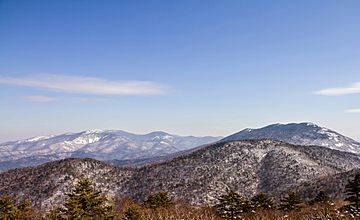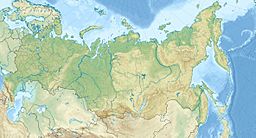Sikhote-Alin facts for kids
Quick facts for kids Sikhote-Alin |
|
|---|---|

Sikhote-Alin is the home to the Amur tiger, which is amongst the largest felines in the world
|
|
| Highest point | |
| Peak | Tordoki Yani (Russia) |
| Elevation | 2,090 m (6,860 ft) |
| Geography | |
| Official name: Central Sikhote-Alin | |
| Type: | Natural |
| Criteria: | x |
| Designated: | 2001 (25th session) |
| Reference #: | 766 |
| Region: | Europe and Asia |
The Sikhote-Alin (pronounced See-kuh-TAY uh-LEEN) is a huge mountain range in Russia. It stretches for about 900 kilometers (560 miles) in the far east of the country. This area is known for its amazing wildlife and tall peaks.
The highest mountains in Sikhote-Alin include Tordoki Yani, which is 2,077 meters (6,814 feet) tall. Other high peaks are Ko Mountain (2,003 meters or 6,572 feet) and Anik Mountain (1,933 meters or 6,342 feet).
Contents
Wildlife and Nature in Sikhote-Alin
Sikhote-Alin is a special place where animals from both northern and southern climates live together. It is a temperate zone, meaning it has mild temperatures.
Animals of Sikhote-Alin
You can find animals usually seen in cold northern forests, like reindeer and the Ussuri brown bear. But you will also see animals from warmer areas, such as the famous Amur tiger and the Amur leopard. The Asiatic black bear also lives here.
Interestingly, there are very few wolves in this region. This is because the powerful tigers are their main competitors for food.
Plants and Rivers
The oldest tree in Sikhote-Alin is a Japanese yew. It is believed to be over a thousand years old!
Many rivers flow through these mountains. They include the Gur River, which is one of the many streams that feed into the large Amur River.
Exploring the Core Zone
Some parts of Sikhote-Alin are very protected. The main part of the nature reserve, called the core zone, can only be explored with special rangers. This helps keep the wildlife safe and undisturbed.
History of the Sikhote-Alin Mountains
The name "Sikhote-Alin" is thought to come from the Manchu language. In Manchu, "alin" means "mountain."
Early Explorations
In the early 1900s, a Russian geographer named Vladimir Arsenyev explored Sikhote-Alin a lot. He wrote several books about his adventures. His most famous book is Dersu Uzala (1923). This book was later made into an Oscar-winning film in 1975 by the famous director Akira Kurosawa.
Because of Arsenyev's work, two large wildlife refuges were created in 1935. These were the Sikhote-Alin and Lazo wildlife refuges. They were set up to protect the unique animals and plants of the region.
The Sikhote-Alin Meteorite
On February 12, 1947, something amazing happened in these mountains. One of the biggest meteorite showers in recent history occurred! The Sikhote-Alin meteorite broke apart in the sky. It rained many tons of metal pieces over an area of about 1.3 square kilometers (0.5 square miles).
These falling meteorites created craters on the ground. The largest crater was 26 meters (85 feet) wide!
World Heritage Site Status
In 2001, UNESCO recognized "Central Sikhote-Alin" as a World Heritage Site. This means it is a place of special importance to the world. UNESCO said it was important for the survival of endangered animals. These include the scaly-sided merganser, Blakiston's fish owl, and the Amur tiger.
The original World Heritage Site covered a huge area of 16,319 square kilometers (4,032,500 acres). The main protected part, the Sikhote-Alin Zapovednik, was 3,985 square kilometers (984,700 acres). In 2018, the site was made even bigger. It grew by 11,605 square kilometers (2,867,700 acres) to include the Bikin National Park. This expanded area is now called "Bikin River Valley."
See also
 In Spanish: Sijoté-Alín para niños
In Spanish: Sijoté-Alín para niños


